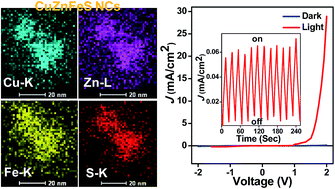Facile synthesis of composition and morphology modulated quaternary CuZnFeS colloidal nanocrystals for photovoltaic application†
Abstract
Quaternary semiconductor CuZnFeS (CZIS) nanocrystals (NCs) with controlled size, shape and composition composed of earth abundant elements have been successfully synthesized using the colloidal synthesis method. The size, shape and composition of the NCs have been controlled by tuning the reaction parameters to obtain NCs in the form of dots, triangles, hexagons, sheets, rods and wires. These quaternary CZIS NCs show high light absorbing properties towards visible to near infrared light with a high absorption coefficient suitable for photovoltaic applications. Utilizing layer-by-layer deposition of CIZS NCs films, heterojunction devices consisting of ITO/PEDOT : PSS/CZIS NCs/Al are fabricated for photovoltaic performance. The devices exhibit excellent rectification behavior (rectification ratio of ∼150) and good photoresponsitivity (on/off ratio of ∼55). The broad range of absorptions with strong extinction coefficient properties of CZIS NCs has been utilized to fabricate quantum dot sensitized solar cells (QDSSCs). Our synthesis protocol marks an advance for chalcopyrite NCs based solar cells and offers a possible template for the synthesis of other ternary and quaternary NCs with robust photoelectric properties.



 Please wait while we load your content...
Please wait while we load your content...